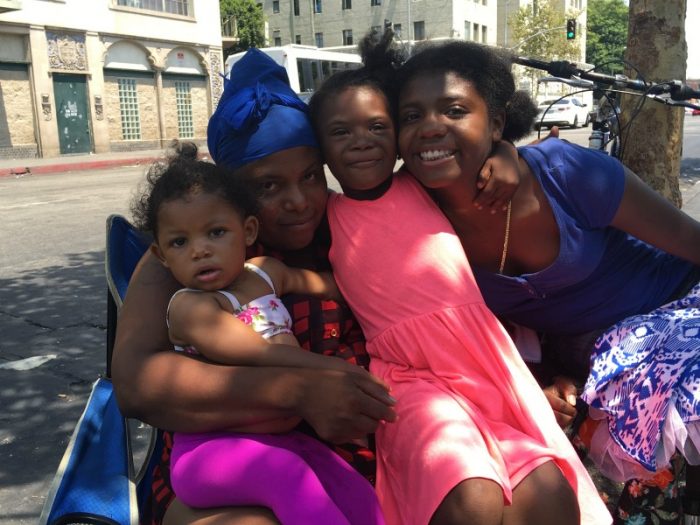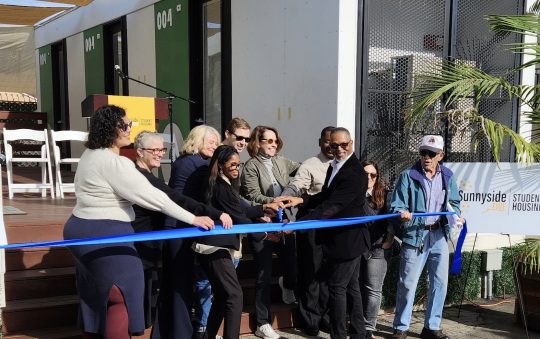
The growing awareness around early childhood education has led advocates in L.A. County and across the country to push for more programs that serve families in low-income communities and communities of color.
But for families living on the street, accessing these programs remains a challenge.
“Some resources I’m getting, but some I’m not,” said Andria Patterson, a homeless mother of three.
Patterson’s two older daughters, Nevaeh, 6, and Sierra, 16, both have learning disabilities. Nevaeh has Down Syndrome, while Sierra was diagnosed with Attention Deficit/Hyperactivity Disorder (ADHD). Patterson says she gets little in the way of help for either of her older daughters from local agencies.
She also says she gets no educational assistance for her youngest, Skyler, who turned one in July. “I don’t have any for her at all,” she said. “They [pre-schools] just tell me I have to wait until she turns two.”
Numerous studies point to the advantages of a quality education for pre-school and kindergarten age children. These include higher incomes and graduation rates, as well as less need for special education and a reduced chance of getting into trouble with the law.
At any given time there are close to 6,000 children ages 0-to-5 who are homeless in Los Angeles County, according to KidsData.org. The trauma of being homeless can have lasting consequences on cognitive development and academic success for many of these children.
Patterson described her own struggle to provide her kids with learning opportunities. “I need reading books, pencils, coloring books, and other things, and I need help managing my six-year-old’s anger issues,” she said.
Barbara Duffield is director of policy and programs for the National Association for the Education of Homeless Children and Youth. “Young people need to do things like move, like play, like explore,” she explained, adding that the “social and emotional parts of early childhood education are especially important for children who are experiencing trauma.”
Duffield cited invisibility as being the number one challenge for homeless families trying to access early childhood programs. Even those like Head Start, which are required to prioritize homeless families, may not always know where to look for them, she said.
“They may not do outreach to places like motels … [that] invisibility, coupled with the lack of awareness among early childhood programs is very likely the number one barrier” to reaching homeless families, Duffield stated.
She recommended improving training of staff at early childhood programs, as well as policy revisions that would reduce or eliminate bureaucratic obstacles and allow for more wrap around services as possible solutions.
According to Barbara Andrade Dubransky, director of Program Development, First 5 LA, lawmakers and the public are beginning to recognize the importance of early childhood education during the 0-5 and the prenatal period.
Dubransky spoke during a April forum for ethnic media organized by New America. Taking on the age-old debate over nature versus nurture, she said the question wasn’t an either/or.
“We know that both the child’s foundational genetics, as well as the experiences they have and the environments they find them in both have an impact on their development,” she explained. “They’re both significant.”
Panelists for the April 25 convening also included Dr. Margaret Yonekura, executive director, LA Best Babies Network, who noted that 75 percent of children under five in L.A. County are children of color.
“Fifty-two percent are Latino and 50 percent are first or second generation immigrants,” she said, adding that California has the highest childhood poverty rate in the nation when adjustments are made for cost of living. “That’s a pretty sobering fact … 50 percent of our children are growing up in poverty.”
Yonekura went on to describe how poverty impedes parents’ ability to provide their children with educational opportunities, including limited options for housing and nutrition, poor neighborhood conditions, a lack of physical activity and access to things like childcare, transportation and health care.
She pointed to programs that can assist L.A. parents, including Perinatal and Early Childhood Home Visiting. L.A. County has a variety of such programs that improve bonding and attachment, and link families to resources within the community, she said.
There is also the National Center for Homeless Education at SERVE and the Migration Policy Institute.
Despite the challenges, however, Yonekura said it was not all doom and gloom.
“Parents are the child’s first and most important teachers,” she said, sharing how her own mother made sure she had books to read through weekly library visits.
As for Patterson, while connecting with available programs is difficult, she said she’s going to make an effort to do so.
In the meantime, she said she does what she can for her youngest, including singing to her, or dancing. “It’s just the basic things I try to do. Sometimes I read to her. Sometimes I just tell her little things … She learns how to pay attention and things like that.”
[Charlene Muhammad wrote this story with support from New America Media’s Early Childhood Education Fellowship program.]







